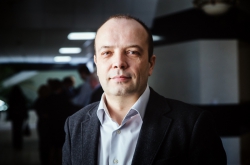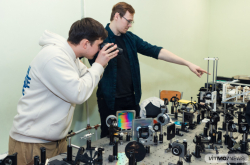Future in LED
LED lighting is gradually taking over from other, more traditional light sources on the global market. According to research by Strategies Unlimited, in 2018 the volume of the corresponding market segment will amount to 25.5 billion USD compared to 14 billion USD five years ago.
The increase in sales of LED indicates a growing demand for the technology. Today, it is most common in industrial, outdoor, architectural and commercial lighting. The shift towards energy-efficient technology is, on the one hand, indicative of government policies on the promotion of energy conservation, and on the other, related to the decrease in pricing of LED lighting. In March 2014, 20 Russian companies presented their products at the international Light and Building expo. Today, Russian companies supply their product to both the domestic and the European markets.

According to Vladislav Bougrov, head of ITMO University’s School of Photonics, energy conservation is one of today’s biggest goals in photonics.
“An important aspect of photonics is power engineering: it concerns the production of energy from photovoltaics and a general reduction in power consumption. LED is an important area in the field of photonics, and it’s been developing actively in the past decade. The industry has grown rapidly, including in Russia, and today in our country we have a unique market that’s largely dominated by Russian companies,” – he says.
While many markets tend to be controlled by major international companies, while Russian companies simply produce specific components for them, the LED area is different in that even a relatively small company can produce both a lamp and a full-fledged intellectual lighting system, notes Prof. Bougrov.
“It’s a very rapidly-growing market; we’ve previously observed growth rates of 30-40% per year, and it keeps growing. This is a rare example of a hi-tech market that’s not limited by the influence of super-large global players, a market where mid-size companies can set the pace,” – he adds.

It’s impossible to make a perfect fixture that would suit every customer. Everything that has to do with lighting tends to be made by individual order, giving yet more opportunities for the development of small and medium businesses. The LED market isn’t limited by just lamps and the like; today, it also involves the design and production of complex intellectual systems used in smart-city projects and lighting design. All this gives small companies the opportunity to use the end-customers’ needs to develop and quickly respond to demands.
Specialist training
ITMO University has been training specialists for the LED market since 2012. Six years ago, as the field developed rapidly, the university launched Russia’s first specialized Master’s program “LED Technologies”.
The program trains specialists who develop and study processes related to the growth of light-emitting nanostructures, and the processing and production of microchips based on these structures; the technologies for design and construction of light diodes and LED devices; and quality control in various fields of technology, including nanoindustry.
The students learn about the methods of production of semiconductor nanostructures, including quantum wells and quantum dots, learn about the relationship between semiconductor nanostructures and light-emitting chips, diodes and diode packages, and about the primary fields in which they’re used. A great deal of attention is paid to device engineering and development of technological processes.

The educational process involves many specialists from the industry’s top companies who conduct lectures and specialized courses.
Lab work
Students of the program are actively involved in the work of ITMO University’s laboratories.
“With “LED Technologies”, while we still have students learn about the working processes at other, external enterprises, most work revolves around the university’s own labs,” – comments Vladislav Bougrov, – “For us, there are two main elements of education; first, it’s having specialists from the industry come in for one-time lectures of educational courses to let the students learn about the industry and how it develops. Secondly, it’s letting the students work at the university’s laboratories. The university works on many orders from industrial companies, and starting in their first year, all students have the opportunity to be involved in the development of exciting, modern and complex systems. It’s a program with a great deal of actual, real work; not just abstract development for its own sake, but actual tasks that exist in an actively developing industry.”
Career prospects
Since the program trains specialists capable of working on applied research, upon graduation they can start their careers at companies working on semiconductor and nanomaterial technology, or apply their skills at ITMO University’s laboratories as researchers.

During their studies, students undergo practical training and take internships at various companies (INTER RAO, O2 Lighting Systems, Vitrulux, LED Microsensor NT) and major research centers and laboratories (Ioffe Institute, SHM R&E Center RAS, IPME RAS).
Graduates can become involved in research, design & engineering, or manufacturing. Major LED development centers can be found not only in Moscow and St. Petersburg, but also in many other regions of the country.
“Graduates have the chance to be on the “frontline” of the industry, in a modern, hi-tech field that is actively growing right now. It’s a great segment where the industry is in direct contact with the end customer; there are also opportunities to start one’s own business. It’s a very competitive market, but one that’s not under great pressure from the big players,” – notes Prof. Bougrov.
Students can also continue their careers in science; the program is carried out in close collaboration with another program, “Functional Materials in Optoelectronics”, which is more science-oriented, and the lab projects are implemented by teams that are closely connected, so anyone can move deeper into science at any point in their studies.

“We do all of our work, including what we do as part of Project 5-100, as part of one international research center; therefore, there are always opportunities to try other things and, perhaps, correct your educational course,” – continues Vladislav Bougrov, – “Students can focus on industry, on our own projects, or, if need be, take up an additional course, of which we have plenty. Since we have several closely-connected research teams and programs, this interconnectedness provides a large number of individual tracks one can choose. It’s not an educational “chute” you go down, but a whole tree where you can move from branch to branch and create your path. We’re proud of being able to provide this opportunity”




